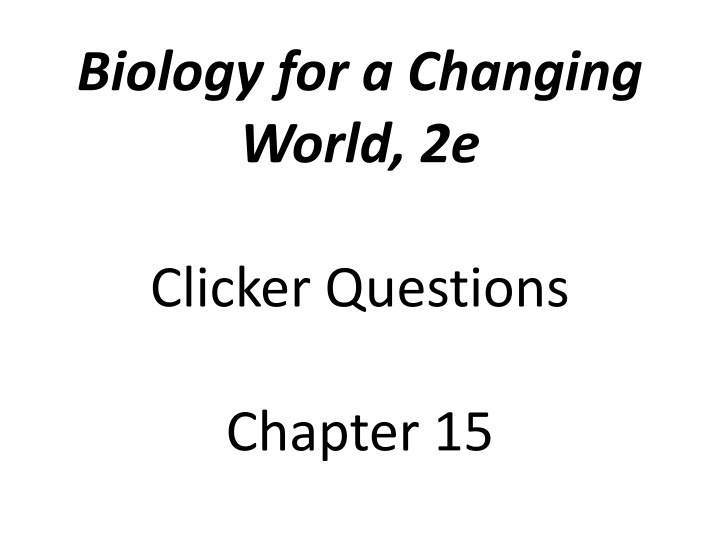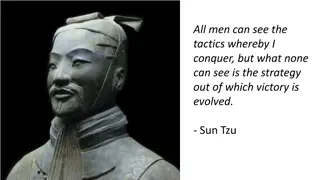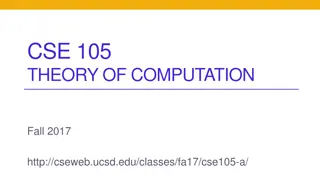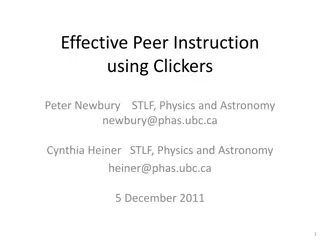
Evolution and Genetic Diversity in Populations
Explore clicker questions on evolution, genetic diversity, and population dynamics, covering topics such as the bottleneck effect, inbreeding, and the impact of environmental changes on different populations. Enhance your understanding of evolutionary processes with these interactive questions.
Download Presentation

Please find below an Image/Link to download the presentation.
The content on the website is provided AS IS for your information and personal use only. It may not be sold, licensed, or shared on other websites without obtaining consent from the author. If you encounter any issues during the download, it is possible that the publisher has removed the file from their server.
You are allowed to download the files provided on this website for personal or commercial use, subject to the condition that they are used lawfully. All files are the property of their respective owners.
The content on the website is provided AS IS for your information and personal use only. It may not be sold, licensed, or shared on other websites without obtaining consent from the author.
E N D
Presentation Transcript
Biology for a Changing World, 2e Clicker Questions Chapter 15
Evolution is A. a change within an individual organism. B. more frequently seen in populations that live in urban areas. C. always occurring to some degree in any population. D. always beneficial to an organism. E. Both B and C.
In a population of 25 mice there are ___ alleles in the gene pool and ___ alleles in each individual. A. 25; 4 B. 100; 2 C. 50; 25 D. 50; 2 E. Not enough information to know the number of alleles.
Which of the two populations shown is more likely to survive environmental change? A B A. Population A B. Population B C. Both are equally likely to survive.
Close relatives breeding are more likely to produce offspring with birth defects because A. The chance of two recessive harmful alleles within the gene pool coming together increases. B. Outbreeding depression may occur. C. More heterozygotes will be produced. D. Hybrid infertility will occur. E. Both A and B.
The figure shown illustrates A. founder effect. B. bottleneck effect. C. adaptive evolution. D. inbreeding depression. E. Both A and C.
The bottleneck effect is an example of A. adaptive evolution. B. nonadaptive evolution. C. genetic drift. D. Both A and C. E. Both B and C.
All of the following generally work to reduce genetic diversity except: A. mutation. B. bottleneck effect. C. founder effect. D. genetic drift. E. inbreeding.
Bottlenecks are most detrimental to A. small populations. B. large populations. C. genetically diverse populations. D. small mammals. E. Both A and C.
Inbreeding tends to A. increase the proportion of homozygous individuals. B. decrease the frequency of recessive alleles. C. increase the frequency of recessive alleles. D. Both A and B. E. Both A and C.
When mice from one population breed with other mice from a second population, this is an example of A. adaptive evolution. B. gene flow. C. heterozygosity. D. the founder effect. E. inbreeding.
Which population will be in Hardy- Weinberg equilibrium? A. a population in which mates are chosen based on their fur color B. a population in which individuals with black fur survive and breed more often than individuals with white fur C. a population undergoing a bottleneck effect D. a population undergoing genetic drift E. No population is ever in perfect Hardy- Weinberg equilibrium.
If a recessive disease affects 1 out of 10,000 people, using the Hardy-Weinberg equilibrium equation, what is the approximate expected frequency of carriers for this disease in the human population? A. 99 out of 100 B. 2 out of 100 C. 1 out of 100 D. 2 out of 10,000 E. 1 out of 10,000
Researchers want to know if a population of monkeys might be inbreeding. They observe one trait for eye color. Brown eye color (B) is dominant to blue eye color (b). Genotyping of 250 monkeys reveals the following: 99 monkeys are BB 100 monkeys are Bb 51 monkeys are bb What is the expected number of homozygous dominant monkeys in this population? A. 39 out of 250 B. 40 out of 250 C. 89 out of 250 D. 99 out of 250
Researchers want to know if a population of monkeys might be inbreeding. They observe one trait for eye color. Brown eye color (B) is dominant to blue eye color (b). Genotyping of 250 monkeys reveals the following: 99 monkeys are BB 100 monkeys are Bb 51 monkeys are bb Is there evidence that these monkeys might be inbreeding? A. Yes B. No C. I don t know.
Researchers want to know if a population of monkeys might be inbreeding. They observe one trait for eye color. Brown eye color (B) is dominant to blue eye color (b). Genotyping of 250 monkeys reveals the following: 99 monkeys are BB 100 monkeys are Bb 51 monkeys are bb What is the evidence that these monkeys might be inbreeding? A. There are more heterozygotes than expected. B. There are fewer heterozygotes than expected. C. There are fewer homozygous dominant monkeys than expected. D. p + q > 1 E. p + q < 1
In which of the following cases would the biological species concept NOT be useful in identifying a species? A. A scientist has fossils of two dinosaurs. B. Two zoos in different cities have a similar looking mammal. C. Two frog populations have slightly different color patterns. D. Two groups of foxes live in slightly different environments. E. The biological species definition would not be useful in identifying whether any of the above are separate species.
If two groups of flowers can mate and produce fertile offspring, then they are A. inbreeding. B. the same species. C. different species. D. possibly the same species, but it is not clear. E. Both A and D.
If ant populations living in the same median strip have mating organs that are incompatible, which of the following is true? A. They are separate species. B. They would most likely produce hybrid offspring. C. They are ecologically isolated. D. All of the above. E. Both A and B.
Two groups of flowers can no longer mate and produce fertile offspring. Originally both were part the same population but were separated by a geographical boundary. What has happened? A. speciation B. allopatry C. reproductive isolation D. All of the above. E. None of the above.









